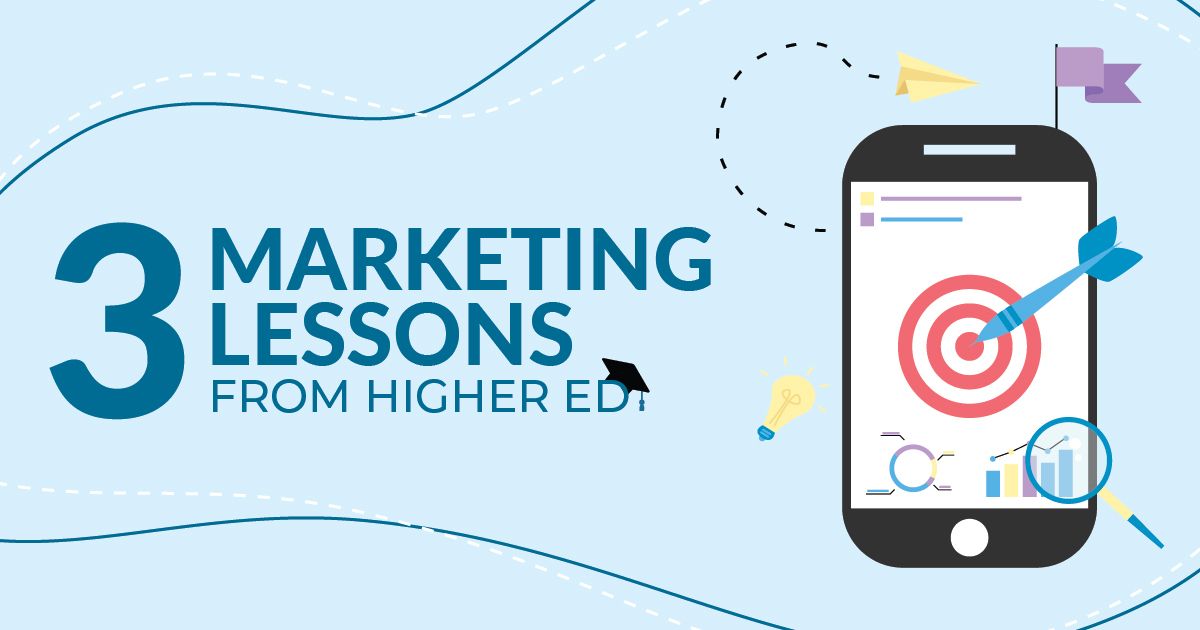There are few industries more fiercely competitive than higher education. Driven by rankings and a desire to churn out the best and brightest minds, colleges and universities are known for their investments in strategic, often high-budget advertising. But luckily for smaller organizations, it’s not the flashy airport banners or expensive commercials that set these higher education campaigns apart—it’s the planning, processes, and surprisingly accessible technologies and techniques at work behind the scenes.
Nearly any industry can borrow the same approach used by higher ed to market smarter and more efficiently. Let’s dive into a few.
-
Think like a recruiter.
As a prospective student, you’re likely to face a list of admissions requirements when applying to a university. The institution wants to make sure they’re not only focusing their resources on the highest achieving candidates, but also admitting students who are the best overall fit for their institution.
Knowing the criteria that makes up their ideal student, they set out to market with targeted digital campaigns in the exact places those candidates are likely to be. And with platforms like LinkedIn (best for reaching potential graduate students), institutions can use targeting parameters like education level, job titles, and years of experience to sculpt an audience for their ads that perfectly matches their admissions criteria. In theory, now every new inquiry coming from advertising is qualified and eligible to become a student—not just a small, hopeful percentage.
Now think about your organization. Why waste marketing dollars reaching those who may not be a good fit for you? Start by identifying the qualifications of your ideal customer. What are their credentials? They’re specific challenges? Do they have certain skills? What are they most interested in? Then, explore what these characteristics might say about their online behavior, their decision drivers, their favorite places to research new information, and even what they are most likely to ask Google. You’ll be well on your way to more streamlined, data-driven marketing with tactics that actually move the needle, not just those that are shiny and new.
-
Align sales and marketing.
Marketing and sales are extremely different beasts. They have different success measures, processes, and teams with distinct skillsets. In higher education, they’re usually housed in separate departments: marketing/communications and admissions/recruitment. This ongoing separation, however, can create communication silos and even competitive situations with little to no productive interaction between the two teams. Unfortunately, this scenario is all too common.
The key is to bridge the gaps and remember your marketing and sales efforts share the same goal—generating new customers. Bring these departments closer to together with a few important steps:
-
Align your metrics. While marketing teams are traditionally focused on quantity (e.g., conversions, impressions, clicks), sales teams are worried more about the quality of their leads. Find ways to quantify quality with marketing data (e.g. lead scoring) to help your campaigns get smarter and prioritize your sales team’s efforts.
-
Share your data. Aligned performance metrics do no good if data isn’t free flowing. Find ways to integrate your marketing and sales systems for more accessible, real-time information to drive decision making.
-
Automate your processes. Now think about ways your marketing team can take repetitive tasks off your sales team’s plate. From sending automatically triggered emails to warm leads based on a specific action, to setting reminders for sales staff to follow-up, an optimized marketing technology stack can speed up meaningful communications with greater efficiency and accuracy.
-
-
Focus on lead generation.
It’s easy to get distracted by clicks and impressions numbers with digital campaigns. But these numbers don’t drive business—and they definitely don’t drive higher ed enrollment. Instead, a signature tactic of higher education campaigns is to directly ask for your information (usually an email address) in exchange for downloading a brochure, accessing more information, or getting in touch with an admissions specialist.
That’s because higher ed institutions know you’re not going to make a decision right then and there. Decision cycles for applying to degree programs can be anywhere from two months to two years. If you’ve already made the impression with advertising, however, why waste the opportunity to tell that user more about your organization, push them closer to a decision, and add them to your email list for future outreach?
Nearly any business that doesn’t rely purely on impulse purchases can benefit from this approach. Let’s say your objective is building demand and selling tickets for an industry conference that’s eight months away. Get started now on a digital campaign encouraging your audience to download an exclusive white paper from the keynote speaker. Your audience will appreciate the opportunity and be much more likely to hand over their email for exclusive information than they would be to buy a ticket on the spot. Now you can keep the communication going, reduce your future advertising costs, and make the big ask at a later date.
Ready to borrow some of these techniques for your next campaign? Get in touch with LMD.

